Established in the Middle East and Egypt on hardstone, copper wheel etching endured as a craft in seventeenth century Bohemia and Dresden on glass. It was used for a range of objectives, including illustrating the royal double-headed eagle (Reichsadlerhumpen) and allegorical themes.
Engravers of this period slowly deserted linear clearness in favour of crosshatched chiaroscuro impacts. A couple of engravers, such as Schongauer and Mantegna, handled glass with a sculptural feeling.
Old Art
By the end of the 17th century, nonetheless, diamond-point engraving was being supplanted by wheel engraving. 2 remarkable engravers of this period are worth mention: Schongauer, that elevated the art of glass engraving to match that of painting with jobs like Saint Anthony Tortured by Demons, and Mantegna, that shaded his illustrations with short scribbled lines of varying size (fig. 4) to attain chiaroscuro results.
Other Nuremberg engravers of this time included Paul Eder, who excelled in delicate and small landscapes, and Heinrich Schwanhardt, that inscribed inscriptions of fine calligraphic quality. He and his child Heinrich likewise created the strategy of engraving glass with hydrofluoric acid to produce an effect that resembled glass covered in ice. The etched surface might after that be reduced and inscribed with a copper-wheel. This approach is used on the rock-crystal ewer shown here, which combines deep cutting, copper-wheel engraving and polishing. Determining the etching on such pieces can be tough.
Venetian Glass
When Venice was a European power, Venetian glassmakers took the lead in lots of high value-added sectors. Unlike fabrics and style, glassmaking preserved a heritage of innovative strategies. It additionally lugged seeds of the decorative grandeur embodied in Islamic art.
However, Venetian glassmakers were not eager to share these ideas with the remainder of Europe. They maintained their artisans cloistered on the island of Murano so they would certainly not be affected by brand-new patterns.
Although need for their product ebbed and flowed as tastes changed and rival glassmakers emerged, they never shed their interest well-off clients of the arts. It is consequently not a surprise that etched Venetian glass shows up in various still life paintings as a symbol of luxury. Frequently, a master gem cutter (diatretarius) would certainly reduce and enhance a vessel originally cast or blown by one more glassworker (vitrearius). This was a costly venture that required fantastic skill, perseverance, and time to generate such in-depth work.
Bohemian Glass
In the 16th century, Bohemian glassmakers adapted the Venetian recipe to their own, developing a much thicker, clearer glass. This made it less complicated for gem-cutter to sculpt similarly they carved rock crystal. Additionally, they developed a method of reducing that permitted them to make extremely comprehensive patterns in their glasses.
This was followed by the production of tinted glass-- blue with cobalt, red with copper and light environment-friendly with iron. This glass was preferred north of the Alps. On top of that, the slender barrel-shaped goblets (Krautstrunk) were also preferred.
Ludwig Moser opened up a glass layout workshop in 1857 and was successful at the Vienna International Exhibition of 1873. He developed a totally integrated manufacturing facility, using glass blowing, polishing and inscribing. Till the end of World War II, his company dominated the marketplace of personalized Bohemian crystal.
Modern Craft
Engraving is one of the earliest hand-icraft methods of attractive practical engraved gifts improvement for glass. It demands a high degree of precision as well as an imaginative creativity to be effective. Engravers have to likewise have a sense of make-up in order to tastefully integrate glossy and matte surfaces of the cut glass.
The art of engraving is still to life and flourishing. Modern strategies like laser engraving can attain a greater level of information with a greater rate and accuracy. Laser modern technology is also able to generate styles that are much less vulnerable to chipping or splitting.
Engraving can be utilized for both industrial and ornamental purposes. It's prominent for logos and hallmarks, along with ornamental decorations for glasses. It's also a prominent way to add individual messages or a champion's name to prizes. It is very important to keep in mind that this is a harmful job, so you ought to constantly use the proper safety devices like safety glasses and a respirator mask.
